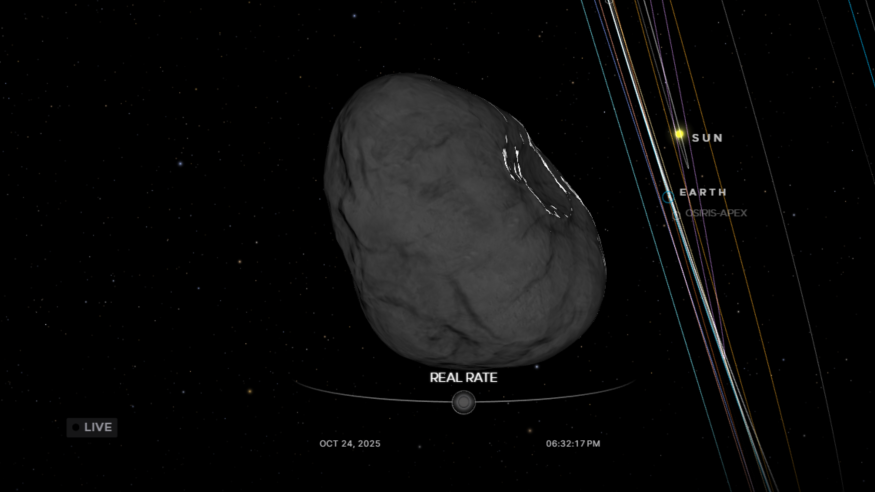
An interstellar comet called 3I/ATLAS (C/2025 N1) will soon reach its nearest point to the sun. The rare visitor, spotted by NASA's Asteroid Terrestrial-impact Last Alert System (ATLAS), will reach this position on 29 October 2025. The object, coming from beyond our solar system, will pass at a distance of 1.4 astronomical units, roughly 210 million kilometres from the sun.
Astronomers across the globe are watching closely. Many hope the event will reveal new details about how material travels between stars. Yet some online have begun spreading fear and speculation, fuelled by comments from a Harvard astrophysicist who suggested the comet's path could hide a deeper mystery.
3I/Atlas To Reach Closest Distance to the Sun
According to Econo Times, NASA confirmed that 3I/ATLAS will reach its perihelion, or closest point to the sun, on 29–30 October 2025. Its trajectory brings it just within the orbit of Mars. The comet will also come within 1.8 astronomical units, or 270 million kilometres, of Earth — a completely safe distance.
The Jet Propulsion Laboratory (JPL) explained that the comet follows a hyperbolic orbit, meaning it did not form within our solar system. It was first detected on 1 July 2025 by the ATLAS telescope in Chile. At that time, it was about 670 million kilometres from Earth.
NASA's Hubble Space Telescope later captured a faint teardrop-shaped cloud of dust surrounding an icy core. Scientists estimate its size could range between 440 metres and 5.6 kilometres. According to NASA, the comet's shape and orbit confirm its interstellar origin.
Will 3I/ATLAS Comet Hit the Sun?
Experts say there is no risk of 3I/ATLAS hitting the sun. NASA and the European Space Agency (ESA) both state that the comet will remain far outside the sun's immediate zone of influence.
Its distance of 1.4 AU keeps it much farther than several comets that have grazed the sun before, including Comet ISON in 2013 and Comet Lovejoy in 2011, which both survived passes as close as 0.01 AU.
NASA stated that 3I/ATLAS poses no threat to Earth or the sun. The agency added that it will continue its journey away from the solar system once it rounds the sun later this year.
3I/ATLAS Observation Could Be Harder
Tracking 3I/ATLAS will soon become difficult. As it moves nearer the sun, glare will block ground-based telescopes. NASA expects the comet to disappear from view around September 2025, making observation nearly impossible until December.
During this period, only space-based instruments like Hubble, Webb, and Swift will be able to gather data. Ground telescopes will resume watching when the comet reappears from behind the sun in early December.
Where Will 3I/ATLAS Go Next?
After 29 October, 3I/ATLAS will speed away along its hyperbolic route. Moving at 60 kilometres per second, it will cross Mars's orbit before leaving the solar system entirely.
NASA scientists believe it will never return, unlike ordinary comets that orbit the sun repeatedly. Professor Darryl Seligman of Michigan State University said the event offers a rare glimpse of material from beyond the sun's neighbourhood, calling it an important chance to study interstellar matter.
October 29 Sparks Concerns
Despite scientific reassurance, 29 October 2025 has drawn attention online. Some concerns trace back to remarks from Prof. Avi Loeb of Harvard University, who described the event as a possible 'black swan' moment. Loeb suggested, hypothetically, that if the comet were artificial, it could perform an Oberth manoeuvre, a method used by spacecraft for acceleration near stars.
He said: 'On 29 October 2025, 3I/ATLAS will reach a perihelion distance of about 203 million kilometres. Was this a coincidence or the result of orbital design?'
Loeb added that the sun's power at that distance could deliver enormous energy to the comet's surface but stressed that 3I/ATLAS most likely remains a natural body. Other astronomers, such as Professor David Jewitt of UCLA, dismiss any speculation.
'It's not a spaceship', Jewitt said firmly via Mashable.
For now, scientists see 3I/ATLAS as a unique scientific opportunity rather than a threat — a visitor passing briefly through before returning to the dark between stars.
Originally published on IBTimes UK
© Copyright IBTimes 2025. All rights reserved.












